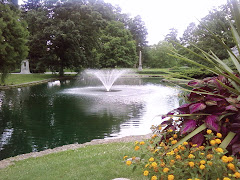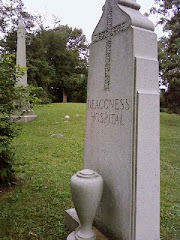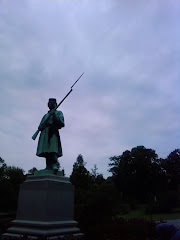
-Week 7-
This week we discussed Spring Grove and its function in our city. I felt highly at ease when we defined the cemetery as a tribute to friendship and community. This made sense to me because Spring Grove is definitely a large asset of the Cincinnati community, in which we are all stakeholders. We also defined a cemetery as somewhat of a home, because like a home, a cemetery is a place to rest and be with family. These two elements everyone seems to honor during death, and the cemetery itself becomes an honorable resting place that is well taken care of. I learned that a cemetery can serve as a reflection to society and it’s the values of the people that uphold the cemetery. I felt struck by this idea and think the fundamental difference between being inside a cemetery and being outside in its city is that a cemetery is more natural and less time conscious. I also gained some insight on John Tallmadge’s idea that man is naturally connected to the wildness of nature, but somehow Spring Grove seems too tame. I think Tallmadge feels this because Spring Grove is intended to be tame, in order to resemble a perfected, more controlled form of nature. The wild, unpredictable elements of nature are therefore replaced by deliberate human design of a picturesque form of nature in Spring Grove. 
 Aside from class discussion, we also spent a good amount of time this week visiting the Memorial Mausoleum. I thought the stained glass windows depicting the Old and New Testament stories were reflective of the mausoleum’s overall design and the botanical styled door and exterior supported the cemetery’s garden feel.
Aside from class discussion, we also spent a good amount of time this week visiting the Memorial Mausoleum. I thought the stained glass windows depicting the Old and New Testament stories were reflective of the mausoleum’s overall design and the botanical styled door and exterior supported the cemetery’s garden feel.  My favorite stained glass window was the one depicting the Virgin Mary and it reminded me of when I was a kid, saying the rosary in church with my grandma. The chapel inside had a stained glass window that was very nature inspiring. As it rests inside the mausoleum, I felt like it would generally be used more for solemn over celebratory events. Every other section we visited possessed an individual stained glass window and different colored marble walls, which served as the entombment for those who are buried in the mausoleum. It was a little eerie thinking that there were bodies buried inside the walls I was walking through, but I was very sympathetic when I saw flowers against all of the many different names.
My favorite stained glass window was the one depicting the Virgin Mary and it reminded me of when I was a kid, saying the rosary in church with my grandma. The chapel inside had a stained glass window that was very nature inspiring. As it rests inside the mausoleum, I felt like it would generally be used more for solemn over celebratory events. Every other section we visited possessed an individual stained glass window and different colored marble walls, which served as the entombment for those who are buried in the mausoleum. It was a little eerie thinking that there were bodies buried inside the walls I was walking through, but I was very sympathetic when I saw flowers against all of the many different names.  Some of the urns in the glass cases were even accompanied with photographs of the people who died which I thought was very respectful but a little sad. One of the urns depicting a couple sitting on a sofa together I thought was very insightful and perhaps the couple thought of companionship as the most meaningful part of life.
Some of the urns in the glass cases were even accompanied with photographs of the people who died which I thought was very respectful but a little sad. One of the urns depicting a couple sitting on a sofa together I thought was very insightful and perhaps the couple thought of companionship as the most meaningful part of life.  The mausoleum halls seemed very empty and I thought how frightening it would be to be locked inside there alone. The basement felt baron as I descended down the empty looking staircase.
The mausoleum halls seemed very empty and I thought how frightening it would be to be locked inside there alone. The basement felt baron as I descended down the empty looking staircase. The basement however, had one of the best stained glass windows in the entire mausoleum. It included some 20th century elements, including the moon landing and the atom, which Albert Einstein studied. My favorite part of this window was the mythological phoenix, rising from its ashes. When I looked at this piece of art I thought about the human condition, as all societies have been inclined to war, but strive for peace. As I was leaving the mausoleum I saw the same guest book I remembered seeing coming in. I thought about signing it to indicate I was visiting but decided not to, because I did not know anyone whom was buried inside.
The basement however, had one of the best stained glass windows in the entire mausoleum. It included some 20th century elements, including the moon landing and the atom, which Albert Einstein studied. My favorite part of this window was the mythological phoenix, rising from its ashes. When I looked at this piece of art I thought about the human condition, as all societies have been inclined to war, but strive for peace. As I was leaving the mausoleum I saw the same guest book I remembered seeing coming in. I thought about signing it to indicate I was visiting but decided not to, because I did not know anyone whom was buried inside.
















No comments:
Post a Comment